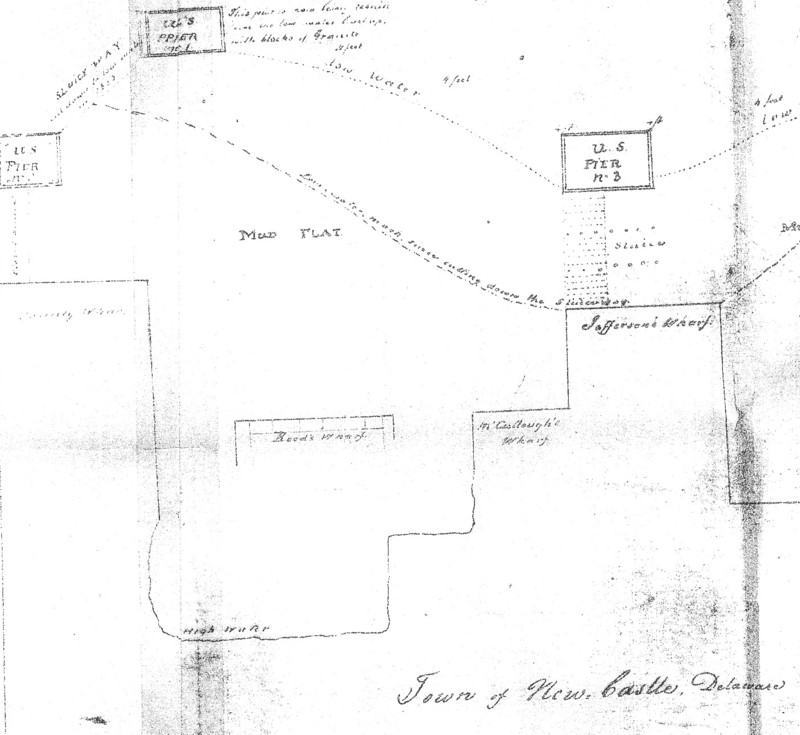History of the Waterfront at New Castle, DE
The Dutch chose the location of New Amstel (New
Castle) in the 1650's for its good harbor at a bend in the South
(Delaware) river. The street they laid out between the site of their fort and the marshes next to Delaware Street has had
wharves ever since. What has changed is its name (Front, Water, The
Strand), the location of the waterline, the
size and number of wharves, businesses, utilities, sail and steamship lines and
the commercial importance of
an unusual landmark -- the 'ice piers'. These stone on top of wood-crib
foundations are listed on the National
Register. They were first built by public subscription in the  late 1700's,
then, the new federal government again chose New Castle, along with Port Penn,
Marcus Hook and Chester as sites to protect
shipping during severe winters when 'ice runs' threatened wooden-hulled vessels.
They were added to and maintained until
1890,
late 1700's,
then, the new federal government again chose New Castle, along with Port Penn,
Marcus Hook and Chester as sites to protect
shipping during severe winters when 'ice runs' threatened wooden-hulled vessels.
They were added to and maintained until
1890,  when
they were no longer of importance.
when
they were no longer of importance.
According to the 1879
report of the Corps of Army Engineers, three of the original 1803 piers were
already on fast land due to silting. Pier B is now adjacent to the Laird's yacht basin, and pier
C is just off-land at the foot of Alexander's alley. By 1879, the low
water line was  near
or past the 600 ft allowance built into the original deeds at the time of
William Penn, and shown on the Latrobe
Survey. Since then,
near
or past the 600 ft allowance built into the original deeds at the time of
William Penn, and shown on the Latrobe
Survey. Since then,  silting
in occurred in the area east of Harmony, and land has eroded in the industrial
area to the west of Delaware. This map
was created by overlaying on top of a 2002 aerial photo shorelines traced from
the Latrobe Survey (1805) and Sanborn insurance maps of 1885 and 1901.
silting
in occurred in the area east of Harmony, and land has eroded in the industrial
area to the west of Delaware. This map
was created by overlaying on top of a 2002 aerial photo shorelines traced from
the Latrobe Survey (1805) and Sanborn insurance maps of 1885 and 1901.
Land based maps, for example the Beer's atlas of
1868 and the 1885 insurance map give a view of the
heavily industrial area on the west edge of town -- including the gas works, railroad
piers, a cotton mill, steel mill and woolen mill. The woolen and cotton
mills were relatively short lived.
industrial area on the west edge of town -- including the gas works, railroad
piers, a cotton mill, steel mill and woolen mill. The woolen and cotton
mills were relatively short lived.
On an 1835 Corps map, just after
the completion of the New Castle and Frenchtown Railroad,
the wharves occupy 100% of the waterfront from Harmony to past Delaware, and are
from the north: County, Bond's, McCullough's, Jefferson's, Riddle's, and
railroad, railroad, railroad! Unfortunately all of the waterfront was now
silted in, apparently due to building a sluiceway in the harbor, and something
that can't be blamed on the late 20th century jetty that runs to Pea Patch
Island.
CURRENT CONDITION: The ice piers are now
partly or severely damaged. Calls have arisen for many years for their
repairs. A state appropriation paid for divers to to examine their
condition. Based on their report, repair was
estimated to cost $1 million/per pier, and so repair is unlikely.

 late 1700's,
then, the new federal government again chose New Castle, along with Port Penn,
Marcus Hook and Chester as sites to protect
shipping during severe winters when 'ice runs' threatened wooden-hulled vessels.
They were added to and maintained until
1890,
late 1700's,
then, the new federal government again chose New Castle, along with Port Penn,
Marcus Hook and Chester as sites to protect
shipping during severe winters when 'ice runs' threatened wooden-hulled vessels.
They were added to and maintained until
1890,  when
they were no longer of importance.
when
they were no longer of importance.


